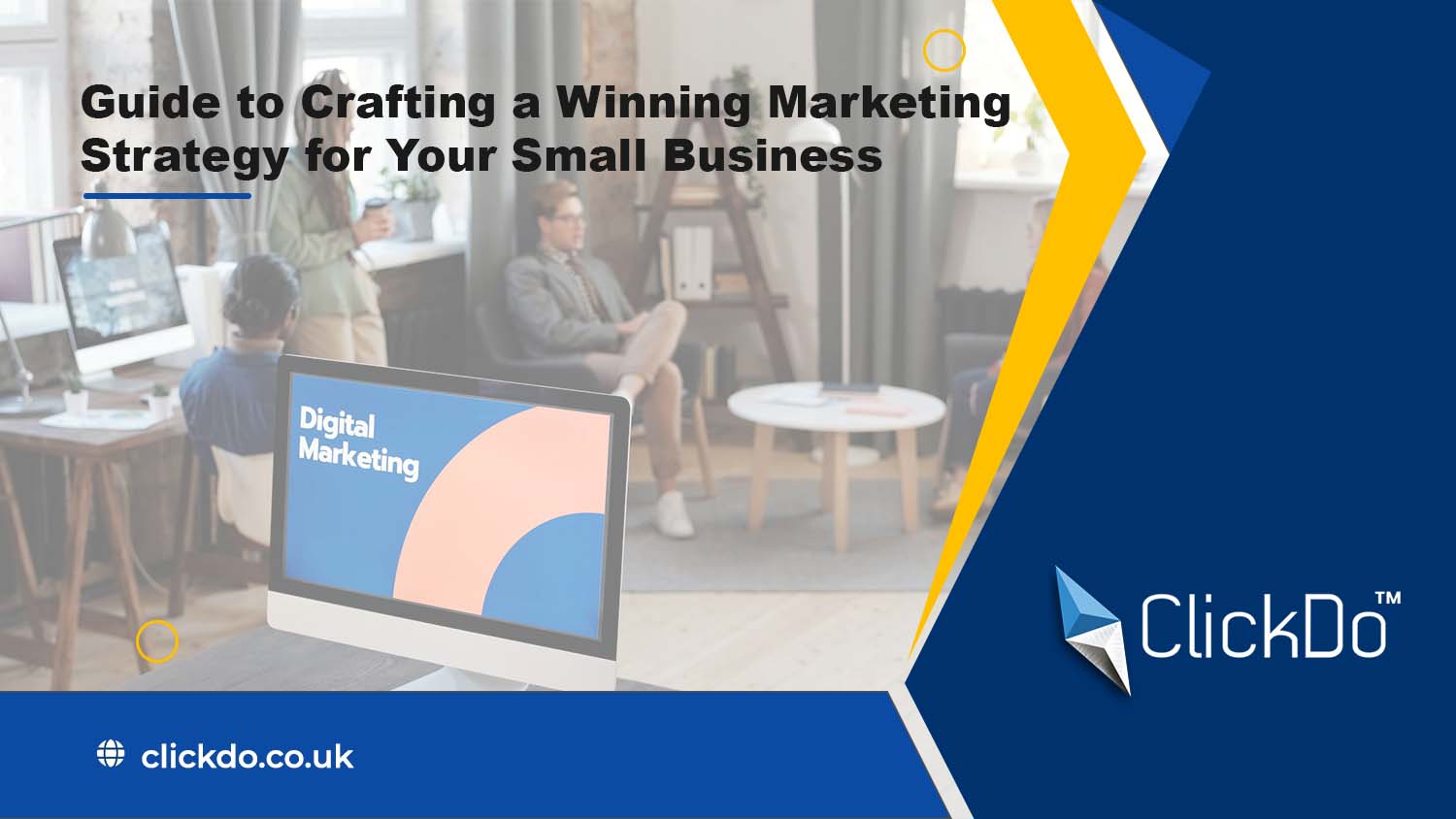
8-Step Guide to Crafting a Winning Marketing Strategy for Your Small Business
Running a small business without a marketing strategy is like trying to win a dance battle with two left feet. Sure, you can flail your arms and hope for the best, but you’re probably not taking home the trophy.
The good news? You don’t need a massive budget or a degree in wizardry to create a marketing strategy that actually works. You just need some wit, a little strategy, and the ability to shamelessly plug your business without sounding like a used-car salesman.
Let’s dive in.
Step 1: Know Your Audience (And No, “Everyone” is Not an Audience)

If you’re trying to market to everyone, you’re marketing to no one. You need to get specific. Who is your ideal customer? Where do they hang out online? What makes them laugh? What makes them cry? What keeps them up at night, other than binge-watching crime documentaries?
To create a marketing strategy that resonates, you need to step into your customer’s shoes (not literally, that’s illegal). Research their behaviors, pain points, and desires. Use surveys, customer feedback, or just stalk their online habits in a totally non-creepy way. Understanding your audience is the first step to creating marketing that doesn’t get ignored faster than an unsolicited LinkedIn message.
Step 2: Craft a Brand That Doesn’t Put People to Sleep
Your brand is more than just a logo and a color scheme. It’s your business personality, and if it has the charisma of a damp sponge, you have a problem. People don’t just buy products; they buy stories, emotions, and the way a brand makes them feel. Think about what makes your business unique and lean into it.
Ask yourself: If my brand were a person, would I want to hang out with them? If the answer is no, you’ve got work to do. Build a brand voice that’s authentic, relatable, and memorable—whether that means being quirky, sophisticated, rebellious, or just really, really good at dad jokes.
Step 3: Content is King, But Not All Content is Royalty

Ah, content marketing. The buzzword that makes small business owners break out in hives. But here’s the thing: You don’t need to write 10,000-word essays on why your product is the best thing since WiFi. You just need content that engages, educates, and entertains.
This could be blog posts, videos, memes, infographics, or even interpretive dance if that’s your thing. (No judgment but maybe test it on a small audience first.) The key is consistency. Show up regularly with high-value content that actually helps your audience, rather than bombarding them with hard sales. If you’re not sure what type of content works best for your industry, check out how professionals showcase their expertise with real work samples that prove their skills.
Step 4: Social Media—The Free Billboard You’re Ignoring
If your business isn’t on social media, you’re essentially that person who refuses to get a smartphone and still carries a flip phone. We respect the dedication, but you’re missing out on a lot.
Social media is where your customers are hanging out, procrastinating, and double-tapping dog videos. Pick platforms that make sense for your business, Instagram for visuals, LinkedIn for B2B, Twitter for snappy banter, and TikTok if you have the stamina to keep up. The goal isn’t just to post about your business but to create conversations, share valuable insights, and make your brand feel like a friend rather than a soulless corporate entity.
Step 5: Email Marketing—Because the Inbox is Where the Magic Happens

People love to declare that email marketing is dead, but it’s actually just the cool kid who refuses to conform. A well-crafted email strategy can drive more sales than any social media algorithm ever will.
Start by building an email list (ethically—no shady tactics). Offer something valuable in exchange for sign-ups, like a discount, a free resource, or an exclusive meme collection (hey, it could work). Then, nurture your audience with emails that are engaging, useful, and not just thinly veiled sales pitches. Remember: If your emails feel like spam, people will treat them like spam.
Step 6: SEO—The Secret Sauce You Can’t Ignore
SEO sounds scary, but it’s really just a game of hide and seek with Google. And if you’re hiding on page 10 of search results, nobody is finding you.
Basic SEO tactics every small business should master include:
- Using keywords your audience is actually searching for (hint: not just industry jargon no one understands).
- Creating high-quality content that answers real questions.
- Optimizing your website speed and mobile experience (because if your site takes longer to load than a microwave burrito, people will leave).
SEO takes time, but once it starts working, it’s like having a 24/7 sales team that doesn’t ask for a raise.
Step 7: Don’t Just “Set It and Forget It” (Marketing is Not a Slow Cooker)

Your marketing strategy isn’t a one-and-done situation. It’s a living, breathing thing that needs tweaking, testing, and improving. Track your metrics, what’s working, what’s flopping, and what’s making your audience run for the hills?
Adjust your strategy based on real data. If a particular post, campaign, or tactic is getting results, do more of it. If something is tanking, pivot. The best marketers aren’t the ones who get it perfectly from the start; they’re the ones who adapt quickly and learn from the process.
Step 8: Make It Easy for Customers to Say “Yes”
You can have the best marketing in the world, but if your website is clunky, your checkout process is a nightmare, or your contact form feels like solving a Rubik’s cube, you’re losing business.
Ensure your site is user-friendly, your call-to-actions are clear, and your services are easy to find. Need inspiration? See how professionals turn visitors into clients with sleek, well-optimized personal websites that showcase their talent effortlessly.
Final Thoughts: Keep It Fun, Keep It Authentic
Marketing doesn’t have to be soul-crushing. It’s an opportunity to be creative, connect with people, and build something that genuinely excites your audience. Stay authentic, experiment with different tactics, and don’t be afraid to inject personality into your brand.
Because at the end of the day, people don’t just want to buy from businesses—they want to buy from brands that make them feel something. So go ahead, make them feel something unforgettable (preferably not regret).
Author Profile
- As the Chief of Marketing at the digital marketing agency ClickDo Ltd I blog regularly about technology, education, lifestyle, business and many more topics.
Latest entries
 Digital MarketingApril 17, 2025From Healthcare to Hospitality: How Businesses in these Sectors can Thrive with Tailored SEO Strategies
Digital MarketingApril 17, 2025From Healthcare to Hospitality: How Businesses in these Sectors can Thrive with Tailored SEO Strategies Digital MarketingApril 8, 2025How AI Is Changing the Future of SEO: Top 9 Tactics for 2025
Digital MarketingApril 8, 2025How AI Is Changing the Future of SEO: Top 9 Tactics for 2025  Digital MarketingMarch 25, 2025Why SEO is a Must for Modern Marketing
Digital MarketingMarch 25, 2025Why SEO is a Must for Modern Marketing Digital MarketingMarch 10, 2025Beyond SEO: How Search Data Powers Market Research and Trend Analysis
Digital MarketingMarch 10, 2025Beyond SEO: How Search Data Powers Market Research and Trend Analysis

